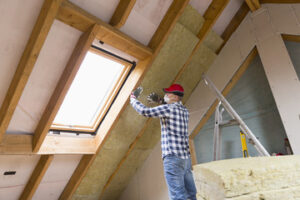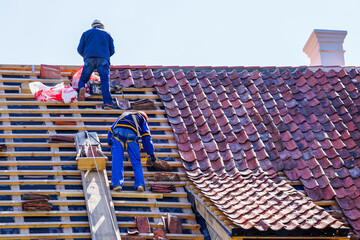Home » Articles posted by Sharon Forrest
Author Archives: Sharon Forrest
Home Insulation Services
Home insulation services help homeowners improve the comfort and energy efficiency of their homes. Insulation contractors can install spray foam or blown-in insulation for walls, attics, and roofs.
Insulation slows the movement of heat from room to room in a house and captures it when the heating is on, decreasing energy bills. Insulation may also reduce moisture issues, like condensation and mold growth. If you are thinking of installing new insulation, Ultimate Radiant Barrier is ready to help.

Installation
Home insulation services can help keep your home warmer in the winter and cooler in the summer, lowering energy bills in the process. Insulation is important for your home’s value as well as comfort, and nine out of ten homes in the United States are under-insulated. In addition, if you have an older home with poorly insulated crawl spaces and attics, re-insulation may be necessary to prevent air leakage.
When you choose a company to install home insulation, make sure they have experience. Ask about their training and certifications, as well as references. Also, ask about the different types of insulation and which would best suit your needs.
A good home insulation service will use an effective insulating material and properly install it in areas where it is needed most. This includes the attic, walls, floors, and crawl space. Sealing air leaks in these areas can cut household energy costs by up to 45%.
While cellulose and fiberglass are two popular options, you should ask about the specific product that is right for your home. Fiberglass is made of tiny glass fibers and is often used for attics and wall insulation. Blown-in cellulose insulation, made of recycled newspaper and denim, is another option for attic and wall insulation. Cellulose is less expensive than fiberglass but does not offer as much insulation.
A good insulator will have insurance and a warranty on their work. This will protect you in case one of their workers is injured or damages your property during the installation. In addition, they should be able to provide you with a copy of their insurance certificate.
During the installation process, the insulation contractor will inspect your home’s attic and walls to determine how much insulation is required. They will then calculate the R-value, or resistance to heat flow, of your attic floor, attic walls, and basement. The contractors will then install the appropriate amount of insulation and close any leaks or gaps in your attic or walls. Once the insulation is installed, your heating and cooling system will operate more efficiently, resulting in lower energy bills over time.
Removal
Whether you’re finishing an attic, doing a home remodel, or adding a new roof, removing the old insulation is often part of the project. The goal of attic insulation removal is to make room for the addition of more insulation that meets current energy efficiency standards. But removing insulation isn’t easy, and it requires safety gear and the right tools for the job.
Attic insulation removal is best done in the fall, so you can take advantage of the cool weather. Using a professional service, this process typically takes from 4 to 18 hours for an attic of about 1,500 square feet. If you do it yourself, you’ll want to spread plastic tarps or drop cloths over your living space below the attic to protect against cellulose dust that will blow down as you remove the old insulation. It will also be helpful to have plenty of large trash bags on hand, and a ladder that is long enough to get you into the attic.
You’ll want to research local waste management organizations to find out where you can drop off your old insulation. Fiberglass and cellulose insulation can’t go in the curb; they need to be taken to an approved disposal site. If you have vermiculite or asbestos in your attic, you’ll need to hire a licensed asbestos abatement specialist.
There are many reasons why you might need to replace your old insulation, including water damage, mold growth, or animals and rodent droppings that can contaminate the insulation with allergens like mites and fleas. If the insulation is wet or has mildew, it can be dangerous to handle, so you’ll need to call an experienced team of home insulation services professionals.
Adding new attic and wall insulation can add significant value to your home, increase the R-value, and help reduce your energy costs. Contact an insulation company today to learn more about our complete home insulation services, including attic and wall insulation removal. Our knowledgeable team is ready to answer your questions and help you get the home you deserve.
Repair
A home with proper insulation is not only more comfortable but also less expensive to heat and cool. A professional contractor can help you select the best insulation for your house, and install it with precision and a minimum of disruption to your living space. The return on investment is high, and the savings will continue for as long as you own your home.
If your home is not well-insulated, it will overtax your heating and cooling systems, leading to higher energy bills. An experienced insulation contractor can recommend the right type and amount of insulation, as well as air sealing to improve your home’s energy efficiency.
Insulation companies can repair gaps, cracks, and crevices around windows, doors, and electrical boxes. They may also insulate ductwork and other ventilation systems to reduce energy costs. Insulation can be made from a variety of materials, including fiberglass batts, cellulose, sprayed foam, or mineral wool.
Fiberglass batts are the most common type of residential insulation. They’re available in a variety of R values and can be installed quickly and easily by a professional. However, they can become damaged by water leaks or mold. A professional can replace fiberglass insulation with new insulation to restore the home’s energy efficiency and comfort.
Blown-in cellulose is another option. It is made from recycled materials and is both safe and effective. It is also a preferred choice for new construction, due to its exceptional energy performance and cost-effectiveness. It is installed by a blower and does not require the removal of existing insulation.
When selecting a home insulation company, be sure to ask for proof of insurance. This will ensure that the company is reputable and can be held accountable for any damage or injuries caused while working in your home. Also, be sure to ask about any warranties or guarantees that come with their work.
A professional insulation contractor can make your home more comfortable and increase its value. They can also lower your energy bills and help the environment by reducing greenhouse gas emissions. They can help you qualify for rebates and tax credits, and offer guidance on clean heating and cooling systems to further lower your energy costs.
Replacement
Insulation can reduce your energy costs by limiting the amount of heat lost in winter and gained in summer. It also provides sound control by keeping outside noises from reverberating inside your home. Depending on your needs, you can choose from a variety of insulation types such as fiberglass, cellulose, and spray foam. An experienced contractor can help you decide which type of insulation is best for your home.
Your local and state building codes may specify a certain R-value for the insulation in your home. However, these requirements can be difficult to meet with existing home insulation. An experienced professional can install additional attic insulation to boost your R-value and provide increased comfort, efficiency, and energy savings.
The primary function of home insulation is to prevent air leaks and keep indoor temperatures stable. However, the effectiveness of insulation degrades over time due to age, harsh weather conditions, and critters living in your walls or attic. When this happens, your HVAC system has to work harder to heat and cool your home, resulting in higher energy bills.
You should replace your insulation if it appears wet, thinning, or damaged. This is particularly important if you have water damage in your attic from a roof leak, or if you see brown or dark spots on your ceiling and walls, which indicate mold growth. Other signs that your insulation needs replacement include an extreme increase in your energy bills, or hearing your neighbors talking and barking dogs even when they are outside.
Although some types of home insulation can be installed by homeowners, it is generally recommended that professionals handle most installations. This is because insulation can be placed in hard-to-reach areas, and specialized equipment may be needed to complete the project. In addition, professional installers can ensure that the installation meets all local and state building codes. This will prevent your home from being subject to a costly inspection. It will also provide peace of mind that the job was done properly and that your home is insulated to the required R-value.
Types of Roof Repair
When it comes to repairing your roof, there are several things to consider, and one of them is the type of materials you choose to use. Knowing the different types and materials available and their prices is important. You can find the best roofing material for your home by comparing the different options.

Identifying the damage to your roof is an important part of roof repair. It is a good idea to take the time to identify the damage to your roof to protect your home and to keep your family safe. Having a qualified professional inspect your home will help identify any problems and can prevent further damage to your property.
While it may not be the first thing you think of when considering your home, your roof can be one of the most vulnerable parts of your house to storms. Storms can cause a number of issues, including leaks, rot, and mold. If you’ve recently experienced a storm, be sure to check your roof for any damage.
The most obvious sign of damage is missing shingles. Other signs include broken tiles, mold, and even moss. However, identifying the damage to your roof can be tricky, especially if you are not an expert in roofing.
Fixing the leak. A leak in the roof can ruin the structural integrity of your home. The best way to fix a leak is to call an experienced roofer or contractor. However, if you’re a do-it-yourself homeowner, you can also fix your leak without the help of a professional.
Before you can make any repairs, you must know where the leak is coming from. A leak can occur anywhere on your roof, but the most common place to find it is in the attic. You can use a flashlight to locate wet spots on the rafters and sheathing.
Once you have found a spot where the leak is coming from, you can use a small hose to isolate it. Run the water for a few minutes in one area.
Repairing a dormer on a roof. A dormer is an extension of your roof that can be used to create extra headroom in your home. It can also be a decorative addition. However, dormers are prone to weather damage. Therefore, you should make sure to fix any issues as soon as possible.
One of the best ways to prevent leaks around dormers is to ensure that the area is properly flashed. If the flashing isn’t installed correctly, water can easily get underneath the shingles and cause major problems.
Another way to avoid leaks is to install a spot sprinkler on your roof. This will mimic rainfall, and it can be plugged into a garden hose so it can be turned on when you need it.
You should also replace any cracked caulking on your dormer. Peel and stick flashing tape can be helpful, too. These seal areas that are hard to get a good seal.
A rafter tail is the exposed end of the rafter. These can be used as a soffit system or as a decorative feature below beams. They are typically scrolled or detailed and extend beyond the structure’s exterior wall.
If you have a rotted rafter tail, you can either replace it with new wood or remove it from the roof. You can use a reciprocating saw to cut away the rotten section of the rafter.
First, remove the underlayment from the rafter to replace a rotted rafter tail. Next, cut the roofing nails on the top of the rafter. This will enable you to fasten a new board to the old rafter.
You will also need to drill into the end of the rafter. Using a screw-tip attachment on a cordless drill, drive a 2-inch deck screw through the upper edge of the rafter tail at 4-inch intervals.
How to Find The Best Roofer
When it comes to roofing, there are a few different tradespersons who specialize in this field. Roofers install, repair, and replace roofs. They use a variety of different materials to complete the job. Listed below are some tips for finding the right Roofer for your home. Listed below are just a few examples of jobs that roofers perform.
 Roofers work on a variety of construction projects, including new installations. To get started on a new roof or repair an old one, roofers must have some carpentry skills. Roofers can replace old materials with new solid structures, such as shingles, wood, and asphalt shingles. Roofing Companies works with different materials, including plywood and metal. In addition to installing new materials, roofers can install vapor barriers and layers of insulation and use various other materials to make the assignment waterproof.
Roofers work on a variety of construction projects, including new installations. To get started on a new roof or repair an old one, roofers must have some carpentry skills. Roofers can replace old materials with new solid structures, such as shingles, wood, and asphalt shingles. Roofing Companies works with different materials, including plywood and metal. In addition to installing new materials, roofers can install vapor barriers and layers of insulation and use various other materials to make the assignment waterproof.
Whether working for a company or a homeowner, roofing professionals need to be physically fit and have excellent balance to prevent falls. They must also be detail-oriented when handling materials, such as shingles or slates. As a result, roofers need excellent hand-eye coordination and strong manual dexterity. Roofing jobs require extensive manual dexterity. They must also be able to use tools, measure accurately, and work in tight spaces. In addition, roofers must be physically fit, as they spend long hours standing on their feet and in hot temperatures.
Most roofs have multiple layers of materials, but low-slope roofs typically contain one layer of asphalt shingles. This means that roofers must be extremely careful to choose the right materials for the job. In addition, roofers can apply “green” roof systems that include a waterproof membrane, root-proof barrier, and soil for plants. Roofers must ensure that these systems remain watertight and that the roof is sturdy enough to support the weight of the soil.
Roofing materials also include asphalt shingles, metal roofing, and wood. These materials protect buildings and their contents. A leaky roof can cause water damage to your walls, ceilings, and furnishings. Roofers also perform reroofing, replacing an old roof on an existing building. They use power nailers to secure the materials. However, some prefer hammer and nail roofing because it gives them more control. You can even request them to repair your existing roof if needed.
Roofing is a great career choice for those who like physical labor and detail. Many Roofers choose to work for themselves as freelancers. While you might be able to work for a large construction company full-time, most jobs require physical labor. Some jobs require working in harsh weather conditions, such as hailstorms. If you enjoy the physical side of your job, you can even start your own roofing company. This job requires more experience and a more competitive salary.
Most residential steep-slope roofs are covered with shingles. To lay these shingles, roofers first place 3-foot-wide strips of roofing felt over the entire roof. Then, they nail overlapping rows of shingles to the roof. Roofers measure and cut the shingles and felt to fit the roof’s angles. They also use metal flashing strips at the corners of chimneys and vents to ensure they are watertight. Roofing cement covers exposed nail heads to prevent water from leaking in.
Roofing contractors use tools such as a hammer, utility knife, and ladders to reach roofs. In addition, roofers use power equipment like hammers and nails to remove old roofing systems. Roofing contractors also use utility knives, crowbars, and hammer tackers to complete the job. These workers also use a tape measure and level to measure the roof’s slope.
While the work is physically demanding, roofing contractors are compensated well. Apprentices start out earning about 50% of what journey workers make. However, they will eventually earn more as they advance through the apprenticeship program. With a high-paying field and a growing number of new construction projects, the job outlook for roofers is bright. The industry is projected to grow by 12 percent between now and 2028. It is predicted that the demand for roofers will continue to grow, even though this growth will be slower than average for all occupations.
Depending on the area of focus, roofers can work in either residential or commercial buildings. Because they must be skilled and safe, roofers can work for both specialty roofing companies and general construction companies. However, roofing contractors must be licensed and display their license number on their marketing materials. The requirements vary from state to state, but most licensed roofers can handle most residential roofing projects. They also have experience with tile, concrete, clay, and lead roofs.